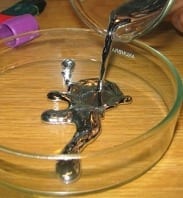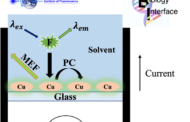Hot spots of mercury pollution in aquatic sediments and soils can contaminate local food webs and threaten ecosystems, but cleaning them up can be expensive and destructive.
Researchers from the Smithsonian Environmental Research Center and the University of Maryland Baltimore County have found a new low-cost, nonhazardous way to reduce the risk of exposure: using charcoal to trap it in the soil.
Mercury-contaminated “Superfund sites” contain some of the highest levels of mercury pollution in the U.S., a legacy of the many industrial uses of liquid mercury. But despite the threat, there are few available technologies to decrease the risk, short of digging up the sediments and burying them in landfills—an expensive process that can cause significant ecological damage.
In a new study published in the journal Environmental Science & Technology, Cynthia Gilmour (SERC), Upal Ghosh (UMBC) and their colleagues show that adding activated carbon, a form of charcoal processed to increase its ability to bind chemicals, can significantly reduce mercury exposure in these highly contaminated sites. With funding and support from several industry and federal partners, the team tested the technology in the laboratory with mercury-contaminated sediments from four locations: a river, a freshwater lake and two brackish creeks. To reduce the harm from mercury, the sorbents also had to decrease the amount of methylmercury taken up by worms.
“Methylmercury is more toxic and more easily passed up food webs than inorganic mercury,” said Gilmour, the lead author on the study. “Unfortunately, methylmercury is produced from mercury contamination by natural bacteria. To make contaminated sites safe again, we need to reduce the amount of methylmercury that gets into animals.”
Added at only 5 percent of the mass of surface sediments, activated carbon reduced methylmercury uptake by sediment-dwelling worms by up to 90 percent. “This technology provides a new approach for remediation of mercury-contaminated soils—one that minimizes damage to contaminated ecosystems, and may significantly reduce costs relative to digging or dredging,” said Ghosh, co-author on the study. Activated carbon can be spread on the surface of a contaminated sediment or soil, without physical disturbance, and left in place to mix into the sediment surface. Called “in-situ remediation,” the use of sorbents like activated carbon has been proven to reduce the uptake of several other toxic pollutants. However, this is the first time activated carbon had been tested for mercury-contaminated soils.
Go deeper with Bing News on:
Mercury Hot Spots
- Breakout Singer/Songwriter Stephen Sanchez Releases 'Angel Face (Club Deluxe)'
Multi-platinum crooner Stephen Sanchez has released Angel Face (Club Deluxe), the highly anticipated follow up to his 2023 debut album, Angel Face. The deluxe album features 5 brand-new songs. Fresh ...
- BOYS LACROSSE: Central Bucks South snaps Souderton’s 8-game win streak
The Central Bucks South boys lacrosse team stopped Souderton’s eight-game win streak Thursday night. And the Titans feel they are just getting started. “It kind of sends the message ...
- Health Officials Issue Consumption Warning for CNY Wild-Caught Fish
The New York State Department of Health has issued new advisories about consuming wild-caught fish in three regions in the state.
- Aaj Ka Rashifal: What effect does the direct movement of Mercury have on the zodiac signs? Know from Acharya Indu Prakash ji
Aaj Ka Rashifal: It will be Good Day for Capricorn, Know About Your Zodiac Sign Aaj Ka Rashifal: Scorpio will go on a trip with Family, Know About Your Zodiac Sign ...
- A Grip on Sports: Yes, who you know is crucial within college athletics but only because relationships are important everywhere
A GRIP ON SPORTS • There are more days than one might think we wake up not exactly sure what we are going to cover in this space. Many more. This is one of them. As always, though, our subject ...
Go deeper with Google Headlines on:
Mercury Hot Spots
[google_news title=”” keyword=”Mercury Hot Spots” num_posts=”5″ blurb_length=”0″ show_thumb=”left”]
Go deeper with Bing News on:
Methylmercury
- Exploring Extreme Environments: A Focus of Research
A quick scan of Emma Bullock’s CV reads like those of many other MIT graduate students: She has served as a teaching assistant, written several papers, garnered grants from prestigious organizations, ...
- White Co. students get scholarships for Southeastern IL College
Two White County students received scholarships to Southeastern Illinois College (SIC). Officials say for 16 years, Black Diamond Harley-Davidson’s co-owners, Rodney ...
- Jeff Corwin teams with Miccosukee to combat ‘super-aggressive’ invasive fish
The wildlife television star hosts a fishing tournament in the Everglades that targets invasive fish that are both outcompeting native fish and impacting Miccosukee traditions.
- Mercury in Seafood: Why Safe Catch stands out
Seafood has long been celebrated for its health benefits, from high-quality protein to Omega-3 fatty acids. However, concerns over mercury levels in fish, particularly large predatory species like ...
- The $6 billion project to power 1 million NY homes with clean energy is the first of its kind
CHPE is a $6 billion project set to start powering 1 million homes with renewable energy in 2026.
Go deeper with Google Headlines on:
Methylmercury
[google_news title=”” keyword=”Methylmercury” num_posts=”5″ blurb_length=”0″ show_thumb=”left”]








